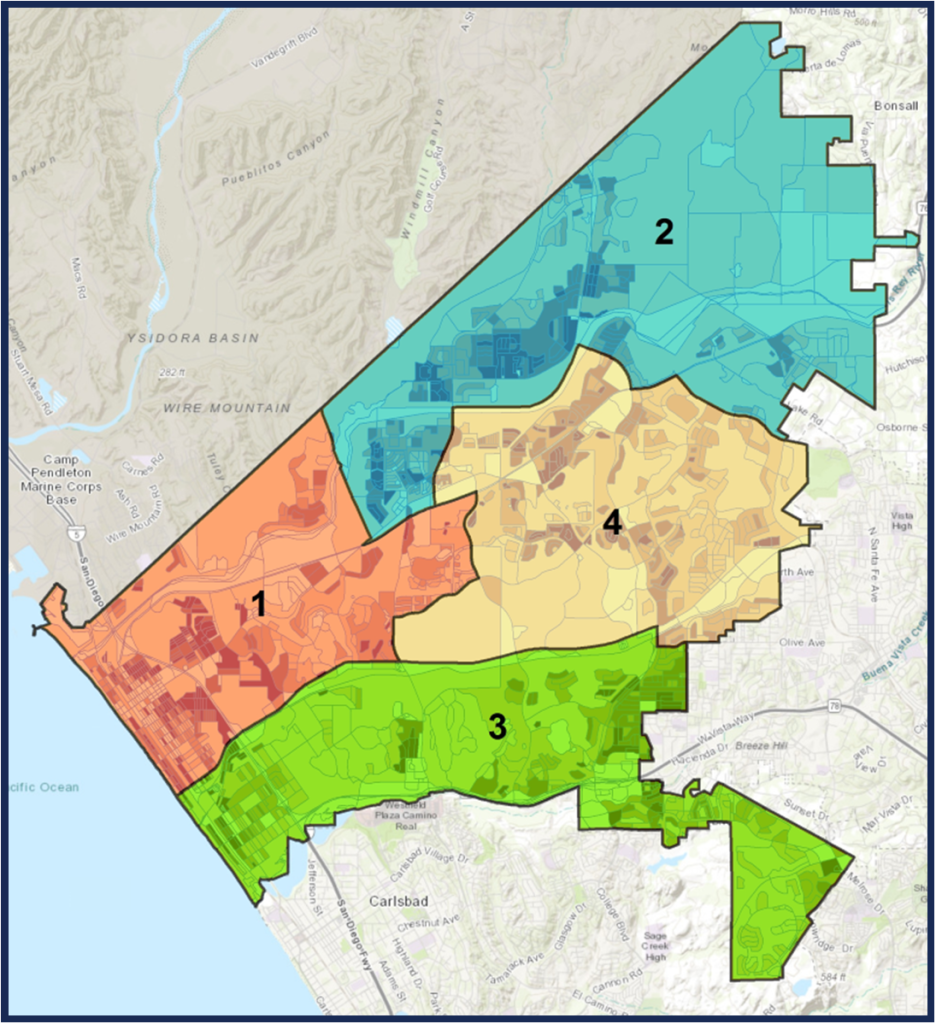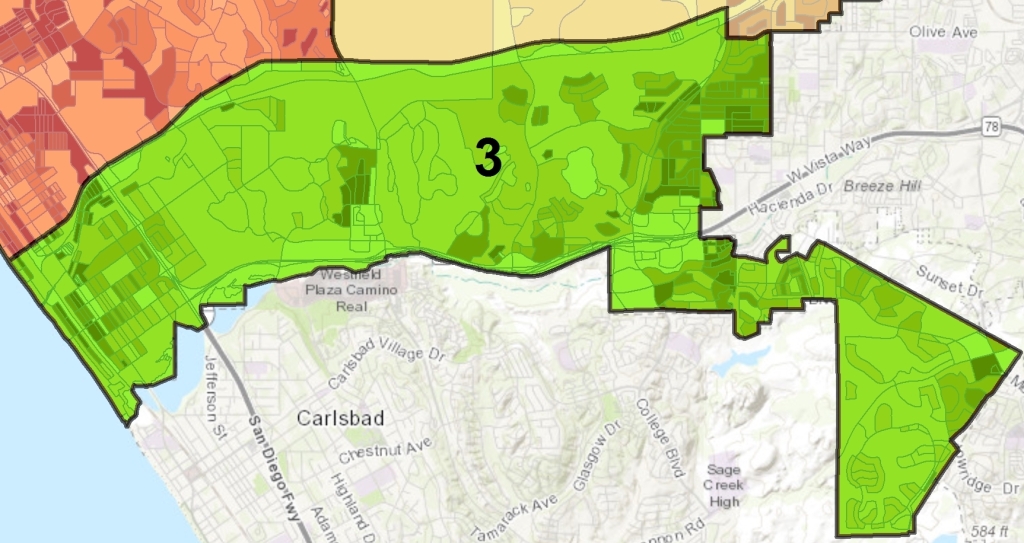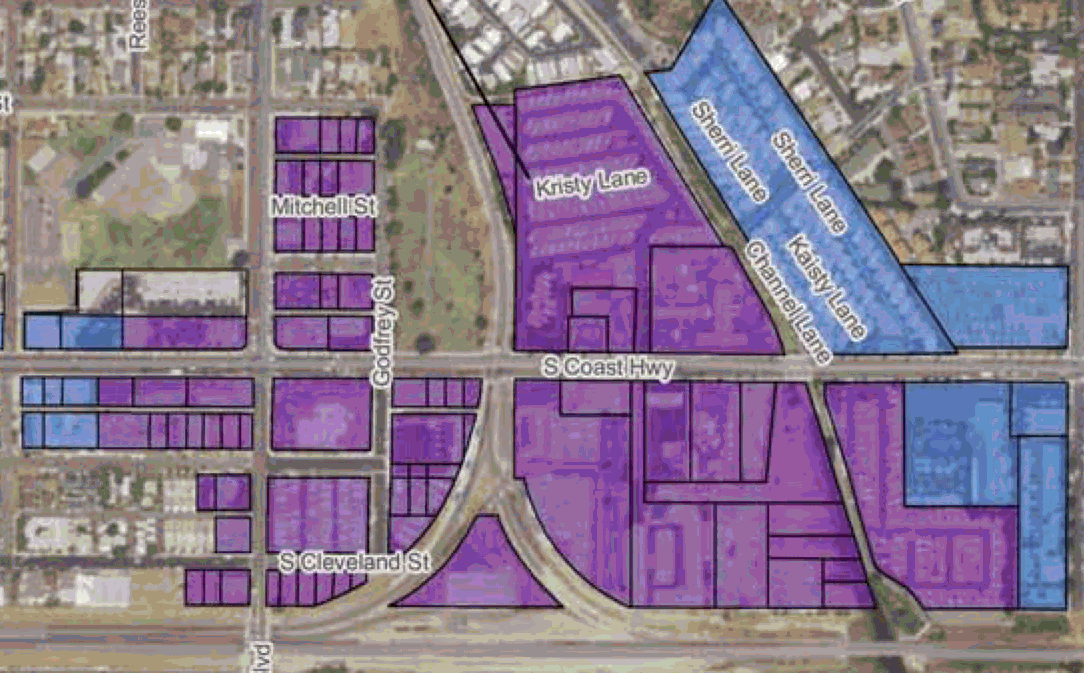Below are the answers to the three remaining questions asked of the candidates for the District 3 city council seat. These are follow up questions to yesterday’s two questions about beaches and parks. As before, we received answers from four of the six candidates:
- Kellie Davis
- Ryan Keim
- Shari Mackin
- Amber Newman
At Tuesday’s live candidate forum (6-7:30pm on Zoom) we (and the candidates) will ask other questions of these candidates.
3. What do you think of the city’s current regulation of cannabis cultivation and distribution? Are there any changes that you would like to make?
Kellie Davis
I do agree with the current direction the City Council is taking regarding the cultivation and distribution of cannabis. I am in favor of creating new revenue streams for our City, and it is my understanding the San Diego County Farm Bureau and some of our local farmers are in favor of the cultivation of cannabis as a viable crop, as other crops have become more problematic to grow, and therefore, less profitable. I support our local farmers in having options to support their families, and our local economy.
Ryan Keim
Balancing access and community safety will be a challenge going forward with the 2016 legalization of marijuana. The city of Oceanside has used a slow and steady approach to cultivation and distribution to ensure we have the ability to address unintended consequences and protect our citizens. Responsible growers and manufacturers were identified and approved in a methodical method so we can accurately assess the success of the program as we move forward. Local governments were given control of the regulation of marijuana so specific issues could be addressed appropriately. Public safety should be a local government’s top priority and it will be mine with the drafting of any further specific ordinances.
Shari Mackin
Currently, the regulatory structure requires both a local license along with a conditional use permit for both cultivation and manufacturing. However, currently cultivation is the only cannabis related activity that allows for both recreational and medical operations and all other types are restricted to medical use only. Although we have a cap of twelve for cultivation uses allowed in Agri-zone, we do not have a cap on the number of manufacturing businesses.
We’ve (the planning commission) had discussions in the past about putting caps on how many breweries and where they should be located. I think it might be time to apply that thinking to marijuana manufacturing businesses in Oceanside. Additionally, I feel a business park/industrial park would be best suited for manufacturing and far, far away from schools, youth centers, and other uses that youth might gravitate to.
Amber Newman
Oceanside’s current cannabis regulations, in their entirety, are woefully inadequate for increasing patient access and/or city revenue. Some of the needed changes are allowing cultivation indoors in industrial areas, expanding zoning for manufacturing, distribution & delivery services to include all industrial and business park zones, and removing the two license cap for delivery services and the twelve license cap for cultivators. We must also allow for storefront dispensaries in both industrial and commercial zones. Further, we should permit all licensed cannabis businesses to operate in the state sanctioned medical and adult-use capacities. Making these adjustments will maximize the potential for this new industry to create good paying local jobs and truly become a contributing factor in our local tax base.
I strongly recommend voting No on Measure M. Overtaxing this emerging industry to the degree Measure M does will not provide the boon our current council seems to think it will. I already know of two businesses that were exploring opportunities in Oceanside until they learned the details of Measure M. More will follow. If we continue to discourage the cannabis industry, we will lose to other cities those gains which should rightfully be ours.
4. The state is strongly encouraging “infill” housing development to increase supply without creating sprawl. Can this be done without changing the character of South O?
Kellie Davis
Infill housing development would change the character of South O, and I do not think it could be done without changing its character. With respect for current and long-term residents, I acknowledge and understand a change like infill housing development may not be a favorable solution for some.
Ryan Keim
Preserving the character of Oceanside and our quality of life needs to shape all land use and zoning decisions in our City. Oceanside is mandated by the State to allow the construction of a specified number of houses to address the “housing crisis.” I disagree with the amount of housing (almost 6000 units) Oceanside is required to provide and will continually advocate to Sacramento for reasonable growth in appropriate areas. It is imperative we constrain height and density to the downtown area to allow our other neighborhoods to retain their current uniqueness and charm. Through the use of underutilized commercial property and available infill lots in the downtown region, we can meet our housing goals without impacting South O, Fire Mountain or any other neighborhood.
Shari Mackin
Yes, absolutely this can be done and needs to be done. South O is unique in that much of our building stock and homes are eclectic; I would push to keep our South O character at all costs. This can be done through our LCP and general plan update and solidified through the use of explicit language and examples of preferred development written into both plans that is focused on retaining character, retains our neighborhood friendly ambience that respects our beachside setting and consideration for scenic views along with size and scale of development. The last thing I would like to see is Coast Hwy becoming an extension of downtown. I believe each segment (South O, Seaside, Downtown, and North Beach) should be looked at separately with regards to the general plan and remain special places that serve neighborhoods and visitors to Oceanside.
Amber Newman
Yes, I believe it can be done while keeping the character of all our neighborhoods. Development is another area where Oceanside could behave proactively vs reactively.
Much like our business community, we don’t need to wait to see what shows up. We can (and should) actively seek out that which is best for our community. We need to identify sites appropriate for infill development and work with the property owners to develop a concept that fits within the neighborhood. Once we know what we expect, then we can seek out developers interested in building to those specifications. Ours is a coastal city, we will not have a problem finding builders who are willing to satisfy our exacting standards.
Areas that should be considered include everything from building heights and architectural features to setbacks, parking and even landscaping. We allow higher density on sites where it makes sense and disallow it where it doesn’t. We make clear what we need from a given project and make them conditions of approval.
5. When the COVID crisis is over, what should the city do to increase jobs and tax revenues?
Kellie Davis
I find it more beneficial to think in terms of increasing household revenue, and not in terms of creating jobs. We should not wait until COVID-19 is over to re-imagine new revenue streams to grow our local economy.
As an example, the other day, “Jackie,” saw our big eucalyptus tree in our backyard, and asked if she and her mother could trim our tree and keep the trimmings, which she then sells to stores. Aside from the gas it took to drive to our home, there were no other out of pocket expense for Jackie; she made a profit, and we now have a trimmed tree. Jackie demonstrates how to use what you have to create new revenue streams, and how to do it with little to no personal financial investment.
As for tax revenues, I am cautious in exploring any further taxing. I prefer to put my efforts in strategizing ways to capitalize on what we presently have to offer and contribute to our local economy, by visioning and creating new revenue streams.
Ryan Keim
As we entered 2020, the city of Oceanside was in the best economic position in recent memory – Oceanside recovered well from the Great Recession with a lean and efficient city government and a thriving business community. This allowed us to respond effectively and quickly to the health crisis without cutting our core services to Oceanside residents.
Going forward, the clearest path to our recovery from COVID will be to continue what we were doing prior to the pandemic – supporting our businesses by removing red tape, listening to their concerns and ensuring the City actually works for them. We can also do this safely while following the health guidelines and keep our per-capita infection rate as one of the lowest in the County.
Fortunately, we have been proactive and started these recovery efforts in early March. I immediately formed an Economic Recovery Task Force to connect the business community with leaders from all levels of government to identify the ever-changing challenges they were facing and this communication will continue. Additionally, I will continue to advocate on behalf of our small businesses to the County and State on a daily basis to ensure they are given the same ability to operate as big-box stores during the health crisis. Small business is the backbone of Oceanside’s economy and their survival is crucial to the success of our City.
Shari Mackin
Small business is the backbone of all business and we must support them during these unstable times. It is difficult to gage the full effect of the virus currently however, I don’t think that waiting until COVID is over to increase jobs and tax revenues is the way to go. The city has an Economic Development Department and that department should be closely monitoring job gains/losses and business additions/closures. Alike, the city’s Financial Services Department monitors expenditures and revenues. I would expect at minimum, to hear from them monthly the trends, both jobs and revenues and the departments are seeing. Upon hearing the report, interventions can be adjusted and/or discussion of applying other strategies and services within the city’s capabilities without jeopardizing our general fund should be discussed.
Currently the city has relaxed parking regulations, allowed for expansion into and allowed permit free use of public spaces, offered a low interest loan program, and outdoor displays. I support these interventions; however, I would like to carefully monitor the progress to ensure that our general fund is not compromised and remains solvent. I have faith in our small business, they are resilient and between small business and our economic development and financial services departments, I feel we have the experts we need at the table to support them while keeping the city solvent.
Amber Newman
Covid really has no significant bearing on what the city should do to increase jobs and tax revenues because what should be done post-Covid is the same thing that should have been done pre-Covid.
We need a proactive and creative business development team that focuses on bringing businesses to Oceanside rather than just approving whatever happens to show up. We need to monitor for available spaces and seek companies we feel would be a good fit for those spaces. We need to encourage local entrepreneurs to set up shop. I would like to see the city offering workshops to help people looking to start their own small business. Perhaps include mentorship opportunities and incentive plans for moving into specific planned areas targeted for re-growth.
We should also take advantage of Covid showing us that many jobs can be done from home and explore opportunities for building live/work spaces. We need to stop converting industrial properties into other uses and find ways to increase our industrial inventory. We need to craft mixed use opportunities so that neighborhood needs are met closer to home and so that longstanding businesses can remain in place as the landscape changes.








 Public records show that the Node properties around the Sprinter station total 38.69 acres. This would allow 2,437 new dwelling units — in addition to any residential development in the (blue) “Avenue” properties, which allow all-residential projects up to 45’ high.
Public records show that the Node properties around the Sprinter station total 38.69 acres. This would allow 2,437 new dwelling units — in addition to any residential development in the (blue) “Avenue” properties, which allow all-residential projects up to 45’ high.